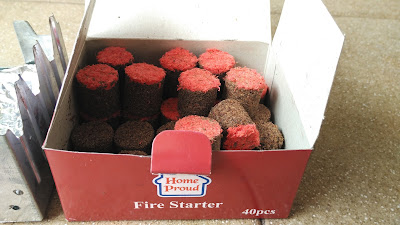I had a box of fire starters lying around and the thought occurred to me that this may serve as a good alternative fuel for my solid fuel stove. These are generic fire starters that can be easily obtained in most supermarkets and cost about $1.40 for a box of 40 cylindrical fire starters.
They are made out of two layers, the top consisting of a thin bedding of cotton fibers dyed with red (wax?) that catches fire easily while the bottom layer is made out of compressed fine wood shavings.
When used as a what is intended to, a single cylinder of fire starter will take about 10 minutes to properly light up enough charcoal for a small sized barbecue pit. The way you stack up the charcoal should allow enough air for effective combustion and to make sure most, if not all the charcoal are directly on top of the flame. I shall talk about stacking methods another time.
I like the fact that these generic fire starters light up easily with a match, unlike the solid fuel . Just hold the match near to the sides of the red tinder layer and off it goes!
Using my Trangia 0.9l kettle, I wanted to test if a single fire starter is sufficient to boil the kettle of water. Unfortunately, it could not and I had to add another piece of fire starter. By then, almost 15min had elapsed. The flame also produced a very thick layer of soot underneath the kettle, in the same way solid fuel does.
Even the 2nd fire stater did not get the water to boil. By the time bubbles were forming at the bottom of the kettle, the fire starter was extinguished.
Hey, I still needed hot water, so I decided to supplemented the stove with some small chunks of solid fuel. After a short minute or two, the water reached a good rolling boil. The flame from the solid fuel is a lot less smokey and seemed to burn a lot hotter than the fire starter.
By now, the kettle is so sooty that I could scratch out my name on the sidewalls. Soot and smoke is an indication that the flame is not efficient, leaving behind fuel in the form of smoke and soot in the process.
Not only that, the fire starters left behind a huge pile of ash, which is yet more unburnt fuel.
In a pinch, it is possible to use fire starters as an alternative to solid fuel, but be prepared to use more fire starters to accomplish the same task and be patient.
It is not an efficient burn. But it may be due to the fact that the composition of the fire starter may be more suitable for starting charcoal because as the charcoal heats up, it reflects heat back onto the fire starter, possibly reaching a high enough temperature to ignite the smoke from the fire starter, which is why the smoke from a fire starter disappears after a while when used to light up charcoal.
Price wise, solid fuel (sometimes known as hexamine blocks or Esbit cubes) can be rather expensive in other countries, which makes sense to use alternative fuels for lightweight camping needs. In Singapore, solid fuel is a very low cost camping fuel as it is a standard issue in the army ration pack. Given the economy of scale, a box of 8 large solid fuel blocks sells for as little as $1.40.








No comments:
Post a Comment